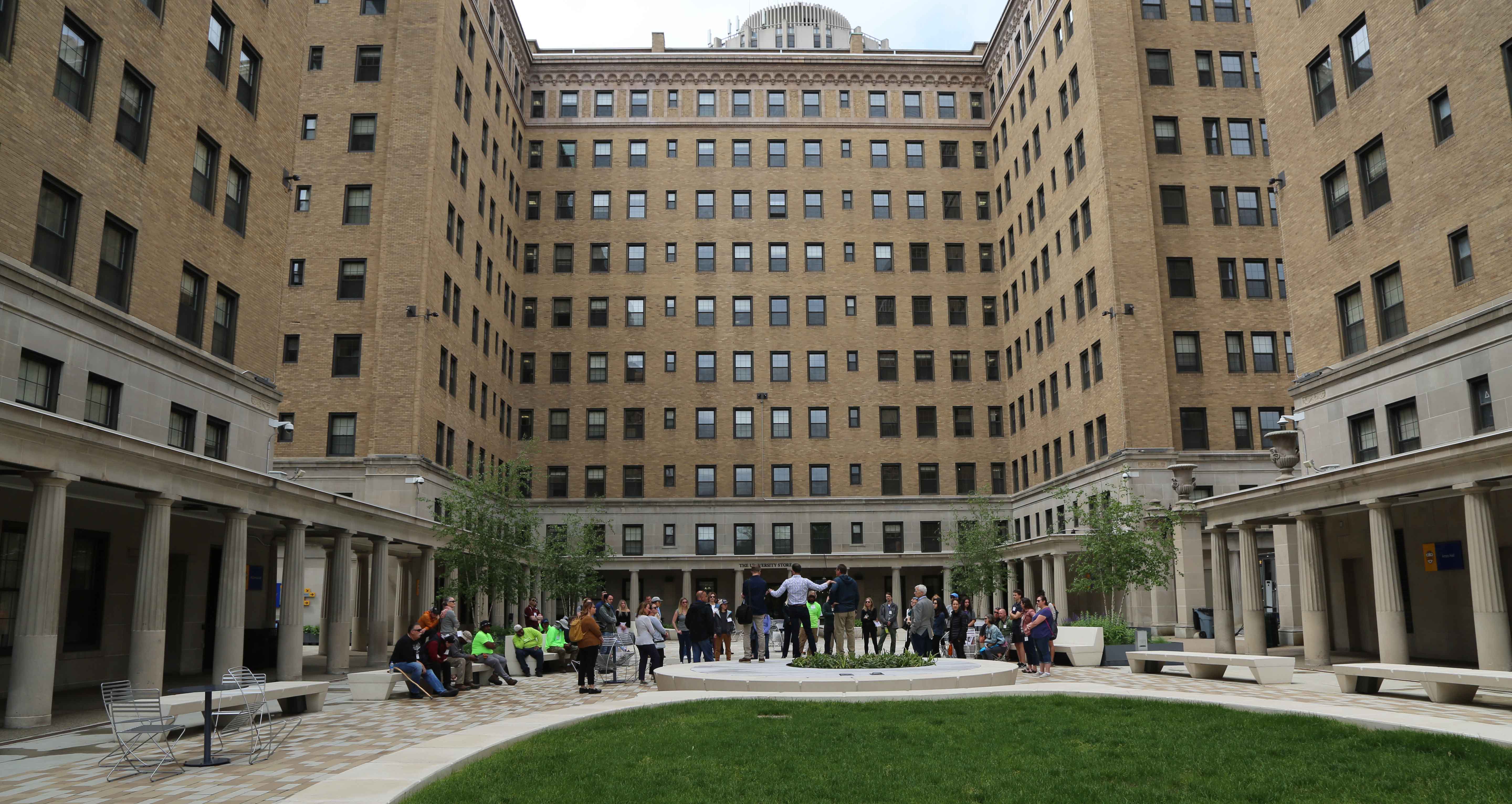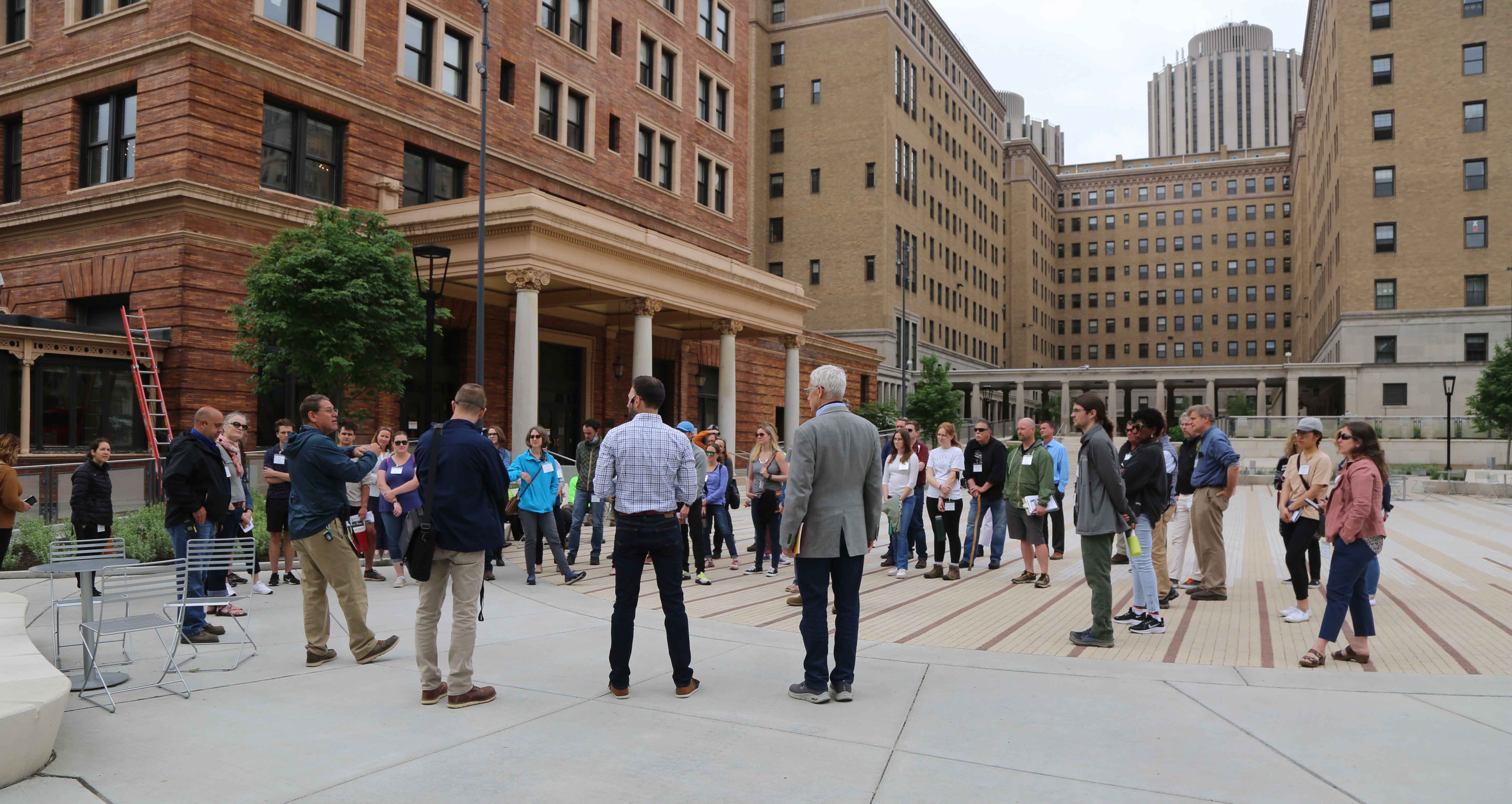
By SUSAN JONES
Sustainability and facilities officials recently got to show off the University’s green stormwater infrastructure to a group of mostly non-Pitt-affiliated design and landscaping professionals, and some of what they highlighted might be a surprise to even longtime members of the Pitt community.
The tour started with the historic lawn between the Cathedral of Learning and Heinz Chapel, where once you could find “ducks on the lawn in puddles,” said Andy Moran, Pitt’s senior manager of grounds.
Western Pennsylvania’s common clay-like dirt didn’t allow for water to filter into the soil below, he said. The area, which is heavily used by students, would often be unfit for any activity, except maybe mud wrestling.
In 2015, the University decided to correct the problem, even though the price to do it right caused some “sticker shock,” said Rob Leibow, director of capital project management.
A large pipe system was installed below the surface that would funnel the water into a rain garden situated between the Varsity Walk and Forbes Avenue, downhill from Heinz Chapel. A top layer of soil and sand, like that found on a golf course, filters into gravel and then into the pipes, said Sean Donnelly of Gateway Engineers, a Pittsburgh-based civil engineering firm that worked on the project.
Now, there are no restrictions on what activities can take place on the lawn — from rugby to volleyball to events in tents. It needs to be reseeded each summer, but not completely rehauled every year.
The rain garden can store up to 1,300 cubic feet of water, or nearly 10,000 gallons, said Dan McDowell of the landscape architecture firm LaQuatra Bonci. In the unlikely event of overflow, there is a berm that flows into grates, down to pipes that empty into the lower lawn.
Pitt also recycles some of the stormwater for use in its chiller plants.
McDowell said the plants are predominantly native to Western Pennsylvania and are hardy in both dry and wet conditions. A hedgerow planted above the garden blocks it from view from the main lawn, but it’s easy to walk down the unpaved path that leads to the Stephen Foster Memorial and see the garden on your right.
The tour also highlighted the work done on Schenley Plaza, which was one of the first projects Leibow was involved with at Pitt. Although the property is owned by the city of Pittsburgh and run by Pittsburgh Parks Conservancy, Pitt got involved, “because it’s our neighbor,” he said. The soil and sand mixture used on the plaza was a model for what Pitt would eventually use on the Cathedral lawn.
Taking out the “highly coveted” parking on the plaza in 2006 was very controversial, Leibow said, but now, “People have long forgotten about the parking. It’s a greatly appreciated public space.”

A more recent project was Schenley Quad, a former parking area between five residence halls next to William Pitt Union that was converted to open space in 2018.
Donnelly said the project was started because of roof and water issues with the parking garage below the plaza. The surface water would run off into stormwater drains or leak into the garage below.
The new pavers are not permeable, because of the garage below, but the plaza is designed to have water drain to the perimeter and into pipes. Subsurface drains catch any water that gets through the pavers. Raised planters with native species also add green space and help absorb some of the water.
The area was designed to blend into the new plaza on the Fifth Avenue side of William Pitt Union and Bigelow Boulevard, which were redone between November 2019 and October 2020.

The William Pitt Union plaza does feature permeable pavers, which actually increased the overall permeability of the space, McDowell said. The entire plaza was raised 18 inches to allow for a bed of stones underneath and more water storage.
The new pull-off spaces on Bigelow Boulevard also have permeable pavers. Any excess water from the plaza area is funneled to a handful of small rain gardens on the edges of the plaza. Liebow said these and other rain gardens on campus help ease the water burden in the Four-Mile Run watershed, which runs through Greenfield into the Monongahela River.
Aurora Sharrard, Pitt’s executive director of sustainability, closed the tour with discussions about upcoming University projects. Stormwater retention is a key goal of Pitt’s Campus Master Plan. This involves reducing or replacing impervious surfaces, adding green roofs, rain gardens and bioswales and cisterns for water reclamation.
Work being done now on the hillside includes ways to collect the water coming down the hill and channel it for use in the Posvar chilled water plant. Runoff from the OC parking lot will be funneled to the new chiller plant being built near the Pitt Sports Dome. The new Campus Recreation and Wellness Center, which will be at the site of the former O’Hara Garage and LRDC building, will incorporate sustainable stormwater management.
Sharrard said when she first arrived on campus in 2018, Pitt was trying to solve stormwater issues on a building by building level and it just wasn’t working. Now the approach is to break the campus into districts and within those areas to balance green and constructed spaces.
Susan Jones is editor of the University Times. Reach her at suejones@pitt.edu or 724-244-4042.
Have a story idea or news to share? Share it with the University Times.
